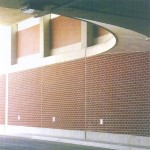Noises and irritating noise are vibrations which are generated at a source. They occur through the use of energy and progress as sound waves. There are two different types of sound:
- Impact sound: Vibrations of solid materials; for example knocking on the wall.
- Air-born sound: Air vibrations; these occur through music or calling out for example.

Airborne sound waves reach the human ear. In addition to the waves that strike the ear directly reflected sound waves are also perceived. This addition noticeably increases the noise level.
Effective noise insulation is possible by absorbing airborne waves, and preventing them from being reflected. In this process sound energy is transformed into thermal energy. The material characteristics of burned klinkerare very well suited to this purpose. Optimized holes pattern layout, wall thickness, and brick form led to the development of GIMA acoustic bricks.
The construction of the sound insulation measure, its wall construction, anchoring, and the interplay of insulation with the acoustic tile define the GIMA sound insulation system.
Technical data
Wall structure of the GIMA sound insulation system.
There are acoustic tile walls in interior areas as well as exterior areas.
Starting with an existing wall, we recommend the following wall construction:
| Air layer | > approx. 2 cm |
| Insulation | > at least 4 cm |
| Acoustic wall | > 5,2; 7,1; 9,0; 11,3 cm (dep. on construction) |
The acoustic tile with horizontal hole pattern is used for interiors.
In exterior areas the noise barrier standard, ZTV-Law 88, requires runoff of rain water, the insulation must be protected from getting soaked. This is why GIMA acoustic tile has been developed with diagonal hole pattern. It must be placed so that the hole pattern runs outwards and downwards.

Sizes & Information data
| Format (dimensions in cm) |
Weight | ||||||
| Length | Width | Height | kg/pc. | ||||
| Raw cut/straight perforation | |||||||
| 24 | 24 | 5,2 | 3,2 | ||||
| 24 | 24 | 7,1 | 4,2 | ||||
| 24 | 24 | 9 | 5,7 | ||||
| 24 | 24 | 11,3 | 7,2 | ||||
| Raw cut/diagonal perforation | |||||||
| 24 | 24 | 5,2 | 3,2 | ||||
| 24 | 24 | 7,1 | 4,2 | ||||
| 24 | 24 | 9 | 5,7 | ||||
| 24 | 24 | 11,3 | 7,2 | ||||
| Smooth cut/straight perforation | |||||||
| 24 | 24 | 5,2 | 3,2 | ||||
| 24 | 24 | 7,1 | 4,2 | ||||
| 24 | 24 | 9 | 5,7 | ||||
| 24 | 24 | 11,3 | 7,2 | ||||
| Smooth cut/diagonal perforation | |||||||
| 24 | 24 | 5,1 | 3,2 | ||||
| 24 | 24 | 7,1 | 4,2 | ||||
| 24 | 24 | 9 | 5,7 | ||||
| 24 | 24 | 11,3 | 7,2 | ||||
| Raw cut/straight perforation | |||||||
| 24 | 11,5 | 5,2 | 1,7 | ||||
| 24 | 11,5 | 7,1 | 2,2 | ||||
| 24 | 11,5 | 9 | 2,7 | ||||
| 24 | 11,5 | 11,3 | 3,2 | ||||
| Smooth cut/straight perforation | |||||||
| 24 | 11,5 | 5,2 | 1,7 | ||||
| 24 | 11,5 | 7,1 | 2,2 | ||||
| 24 | 11,5 | 9 | 2,7 | ||||
| 24 | 11,5 | 11,3 | 3,2 | ||||





